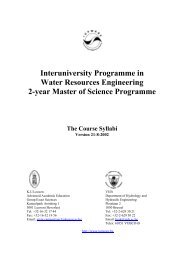CFHT operating manual - Homepage Usask
CFHT operating manual - Homepage Usask
CFHT operating manual - Homepage Usask
Create successful ePaper yourself
Turn your PDF publications into a flip-book with our unique Google optimized e-Paper software.
ESPaDOnS: thermal response and spectral stability http://webast.ast.obs-mip.fr/magnetisme/espadons_new/stability.html<br />
Spectral stability<br />
By taking calibration frames during a complete night (at a rate<br />
of one every 10min) and by correlating all images with respect<br />
to the first one in the series, it is possible to see how the position<br />
of the spectrum with respect to the ccd varies with time; this<br />
experiment is very useful to estimate how much spurious<br />
spectral radial velocity changes are induced by thermal and<br />
mechanical relaxation within the spectrograph. The graph on<br />
the right show the changes in the radial velocity of the thorium<br />
spectrum (in km/s, full line) with respect to the first spectrum<br />
of the series, while the 2 other curves depict the corresponding<br />
temperature and pressure changes (in deg and mbar, dashed<br />
and dash-dot line respectively) throughout one night.<br />
We find that the position of the thorium spectrum with respect<br />
to the ccd varies by typically:<br />
-3.5 km/s per deg change in the spectrograph<br />
temperature;<br />
0.3 km/s per mbar change in external pressure.<br />
Once the temperature and pressure effects are subtracted off, the residual changes in radial velocities, equal to about 20m/s<br />
rms, indicate what the true absolute stability of the spectrograph is. Note that this experiment demonstrates clearly the need for<br />
an outer enclosure with thermal regulation to reduce the shifts with temperature as much as possible and make them depend<br />
mostly on pressure.<br />
From such a series of thorium frames, we can also estimate the relative stability of the instrument (with respect to a given<br />
spectral reference). Using the even thorium frames as the reference and the odd thorium frames as the test spectrum whose<br />
stability is to be checked, we obtain that the relative stability is better than 10m/s rms, for a time lag of less than 10min between<br />
the object and reference measurements.<br />
© Jean-François Donati, last update May 10 2004<br />
2 of 2 08/07/04 11:30 PM

















